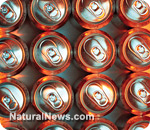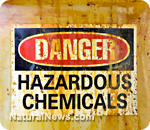welcome
|
||||
Brominated Vegetable Oil (BVO)Toxic Flame Retardant In Your Food! BVO, a substance patented as a flame retardant and banned as a food ingredient throughout
Europe and in Japan is present in 10% of all soft drinks in the US. The December 12, 2011 issue of Environmental
Health News reviews the history of this toxic ingredient, including the fact that "extreme soda binges - not too
far from what many video gamers regularly consume" have resulted in skin lesions, memory loss and nerve
disorders.
Brominated Vegetable Oil (BVO)
Flame Retardant Chemical Banned in Europe and Japan Used in U.S. Soda for Decades
Anthony Gucciardi Why has a flame retardant chemical banned in Europe and Japan been used as an ingredient in North American sodas for decades? If you live in the United States and drink citrus-flavored sodas such as Mountain Dew, you may be ingesting this substance that has health professionals up in arms. A synthetic chemical known as brominated vegetable oil (BVO) — first patented by chemical companies as a flame retardant — is increasingly being identified as a threat to your health, but soda companies still have yet to remove BVO as an ingredient. Added to about 10% of sodas in North America for decades, BVO has reportedly led to soda-drinkers experiencing skin lesions, memory loss, and nerve disorders. Interestingly, these are all the symptoms of overexposure to bromine. What is most concerning is the fact that studies have found that BVO can actually build up in human tissue, accumulating in large quantities over long periods of soda consumption. Industry Reports Set “Safety Limit” on BVO Is it any surprise that reports from a group within the industry were instrumental in establishing limits on what the FDA considers a “safe limit” for BVO in sodas? Scientists have disputed the supposed safety level, stating that not only is the data frail, but the research is several decades old and needs to be re-examined. Meanwhile, soda drinkers are being exposed to this toxic flame retardant chemical on a daily basis. It is not uncommon for some Americans to drink upwards of 5-6 sodas per day, and Mountain Dew is a popular choice among soda lovers.
Imagine the amount of BVO that has accumulated in the tissue of a lifelong soda drinker. How can you tell which sodas contain BVO? Well, Mountain Dew, Squirt, Fanta Orange, Sunkist Pineapple, Gatorade Thirst Quencher Orange, and Powerade Strawberry Lemonade or Fresca Original Citrus all contain BVO. This is a not a complete list, however, and it is important to check the ingredient list. Sodas should be avoided regardless of BVO content, as BVO is not the only ingredient you need to worry about. Many sodas contain mercury-filled high-fructose corn syrup, or the carcinogenic artificial sweetener aspartame. You can even hold a bottle of Mountain Dew up to a light and see the presence of BVO. BVO creates the cloudy look of the beverage by keeping the ‘fruity flavor’ mixed into the drink. Without the presence of BVO, the flavoring would float to the surface and separate. Please visit Natural Society for more great health news and vaccine information.
http://www.naturalnews.com/034448_brominated_vegetable_oil_soft_drinks_chemical.html#ixzz2KXavJYU9 (NaturalNews) A substance patented as a flame retardant and banned as a food ingredient throughout Europe and in Japan is present in 10% of all soft drinks in the US. The December 12, 2011 issue of Environmental Health News reviews the history of this toxic ingredient, including the fact that "extreme soda binges - not too far from what many video gamers regularly consume" have resulted in skin lesions, memory loss and nerve disorders. Fruit-flavored flame retardantMountain Dew, Fanta Orange, Squirt, some flavors of Gatorade and Powerade, as well as other fruit-flavored beverages contain brominated vegetable oil (BVO). On the Nutrition Connection page of its website, the Coca-Cola Company, which manufactures Fanta, defines BVO's as "stabilizers to prevent the citrus flavoring oils from floating to the surface in beverages." In other words, as Environmental Health News explains, BVO weighs down the citrus flavoring so that it mixes with the other soda ingredients, just as flame retardants slow down the chemical reactions which can cause fires. FDA says safe?Brominated vegetable oil is derived from soybean or corn and contains bromine atoms. BVO was
removed from the FDA's "Generally Recognized as Safe List" for flavor additives in 1970. The Flavor Extract
Manufacturers' Association subsequently petitioned to get BVO re-approved, this time as a stabilizer rather than a
flavor additive. Following the submission of industry-generated studies showing that BVO was harmless when present
in soft drinks within "safe limits." The FDA in 1977
granted "interim approval" for use of the substance, limiting it to 15 parts per million. That interim has so far
lasted 30 years. The Environmental Health News article quotes an FDA spokesperson as saying that re-examining the
status of BVO "is not a public health priority for the
agency at this time." Recent ResearchBoth animal research and human studies of bromine have demonstrated its toxicity, finding links to
lowered fertility, early puberty onset and impaired neurological development. Studies have also shown that bromine
builds up in the heart, liver and fat tissue. The accumulation may also appear in breast milk. Because of this
evidence, some health safety experts are concerned about bromine's use even as a flame retardant which can be present in many household
items. Chemicals, Dollars and HealthThe perspective of other countries on this US public health concern offers some interesting
perspective. Wim Thielemans, a chemical engineer at the University of Nottingham in the United Kingdom, points out
soda manufacturers use natural hydrocolloids to perform BVO's emulsification function in countries where BVO is
banned. Since there are viable alternatives to BVO's, Thielmans speculates that "the main driver for not replacing
them may be cost."
"In a recent study of best-selling grocery store products, researchers discovered that almost 50 percent of the sampled peanut butter and deli meats, as well as turkey, fish, beef and other fatty foods, contained hints of a flame retardant normally utilized in the foam insulation of building walls."
Flame retardants found in common grocery store foods
(NaturalNews) Pressure on chemical companies from legislators is
mounting on the issue of toxic chemicals in hundreds of consumer products. Senator Frank Lautenberg has introduced
the Safer Chemicals Act, a bill that would require chemical makers to prove their substances are safe before they
are approved for use. Although one might expect this requirement to be the current standard, this is not the
case.
Brominated vegetable oil: PepsiCo and Coca-Cola not removing chemical from Canadian drinks
By: Carys Mills Staff Reporter, Published on Tue Dec 18 2012
Major soft drink-makers and Health Canada say the use of brominated vegetable oil in Canadian beverages is safe, despite a growing movement elsewhere to ban its use. The additive, which is used to cloud and stop separation in some drinks, has been banned in most of Europe for decades and Japan recently discontinued its use. However, BVO continues to be used in popular drinks sold in Canada, including some flavours of Gatorade, Powerade, Fresca, Mountain Dew and Amp Energy Drink. In the U.S., the Food and Drug Administration’s approval of the additive has come under scrutiny this month after Mississippi teenager Sarah Kavanagh started a petition demanding that PepsiCo stop using the ingredient in Gatorade. She wrote on change.org, a petition-hosting website, that she was prompted to take up the cause after Googling the ingredient found on her Gatorade label and discovering that it was banned in many countries but not her own. “(I)t’s not necessary. . . there is enough information out there that entire countries have banned this chemical product,” Kavanagh wrote on her petition, which has more than 198,000 online supporters so far, including Canadians. After consuming several drinks daily containing BVO, some people have reported symptoms including loss of muscle coordination, memory loss, headache and fatigue, according to a study published this summer by the University of Hohenheim, Stuttgart, Germany. BVO is classified as a food additive, but there is limited knowledge of its composition, the researchers found. It does contain bromine, which is also in flame retardants and has been found to build up in body lipids. Health Canada spokesman Sean Upton said there are no health risks associated with BVO when the density-adjusting agent is used according to regulations, which sets out that 15 parts per million can be used in citrus or spruce-flavoured beverages as consumed. “Health Canada is not currently reconsidering the approval of brominated vegetable oil,” Upton said in an email. “However, Health Canada continually monitors the scientific literature to identify new results of studies relevant to the safety of food additives.” If a risk is evaluated for an additive, the department will take action appropriate for the level of risk, Upton said. BVO was used in Canada prior to the creation of Health Canada’s additive table in 1964. It was formally added to the table with its current restrictions in the late 1960s or 1970s, Upton said. The soft drink ingredient was first used in 1931 and is derived from soybean oil to stabilize flavour oils, according to Pepsi’s website. Dave DeCecco, PepsiCo North America’s vice president of communications, said all of the company’s products are safe and ingredients are constantly evaluated to make sure they meet regulations. In Canada, Pepsi products that include BVO include Gatorade Perform Orange Thirst Quencher, Mountain Dew and Amp Energy Drink. “We follow the regulatory guidelines in every country in which we operate,” DeCecco said. “Health Canada confirms that BVO is safe. If that were to change, we would absolutely comply with any new regulation.” Coca-Cola Refreshments Canada also uses the ingredient in beverages including Fresca and some Powerade flavours. “The safety and quality of our products are our highest priorities,” said director of brand communications Shannon C. Denny in an email, “and we comply with all applicable regulations everywhere we operate.”
"More and more over the past 25 years, brominated
flame retardants have been used in home furnishings and electronics to slow down fires. These chemicals are now
routinely found in household dust, food, air and in the umbilical cords of
newborns."
(NaturalNews) More and more over the past 25 years, brominated flame
retardants have been used in home furnishings and electronics to slow down fires. These chemicals are now routinely
found in household dust, food, air and in the umbilical cords of newborns. PDBEs attack on the thyroidHalogens consist of bromine, chlorine, fluorine and iodine which are all similar in atomic structure. PBDEs are
made from bromine and have a similar chemical structure to iodine in thyroid hormones. Thyroid hormones act in
every cell in the body to perform a wide-ranging role in metabolism, growth and overall development. PBDEs
interrupt thyroid function, causing changes in brain development. Mouse studies show early life exposure to PDBEs
increases hyperactivity, impairs learning and alters motor development. How we are exposed to more and more chemicalsIn 2006, the U.S. Consumer Products Safety Commission approved a federal regulation (16 CFR 1640)
enforcing a very strict - national flameproof mattress standard, mandating all new mattresses to withstand a
two-foot wide blowtorch open-flame test, for 70 seconds. Cheaper chemicals in higher amounts instantly went into
all mattresses, sofa beds, futons, cribs and fold out beds that are included under the regulation. Epic fail!Arlene Blum, a visiting scholar in chemistry at the University of California, Berkeley, and executive director of the Green Science Policy Institute says: "U.S. manufacturers treat furniture with... either tris (2,3,-dibromopropyl) phosphate, a known cancer-causing agent, or a trademarked mix of four chemicals called Firemaster 500"..."In the U.S., we the have highest levels of flame retardants in our dust and in our bodies." But there's little evidence that these chemicals are making a difference in the number of fires that take place. In fact, Blum says, "[chemical] flame retardants aren't very useful in reducing fire hazards because they slow fires by just a few seconds." The bottom lineThe conclusion of the fire retardant study shows that in a genetically susceptible population, PBDE exposure can
have strong effects and can tip the balance toward autism. These researchers examined only one environmental
chemical in autistic behaviors. Autism is a
multifactorial disorder and not just limited to PBDEs.
The Next Deadly Poison In Soda - Brominated Vegetable Oil (BVO)
http://www.naturalfoodsdiet.org/the-n...
The Iodine Conspiracy [BVO AND SODIUM FLUORIDE ADDED TO FOOD AND WATER SUPPLY - HEALTHY IODINE REMOVED]
Protect Your Family
MORE:
FOOD FIGHT: A boy must escape a world where the processed food is killing his neighborhood -- literally.
SHARE to teach kids who is behind it, and how to escape.
REACH OUT TO OTHERS [Help Educate Family And Friends With This Page And The Links Below]
MORE: Monsanto | GMO Genetic Armageddon! | GMO Analyzed | GMO More Info | GMO Cloning Program | GMO at WHOLE FOODS | Aspartame is Made of GMO Bacteria Feces | Soft Kill Depopulation Prgm. | Depopulating The Third World! | Depopulation Agenda
| ||||





















